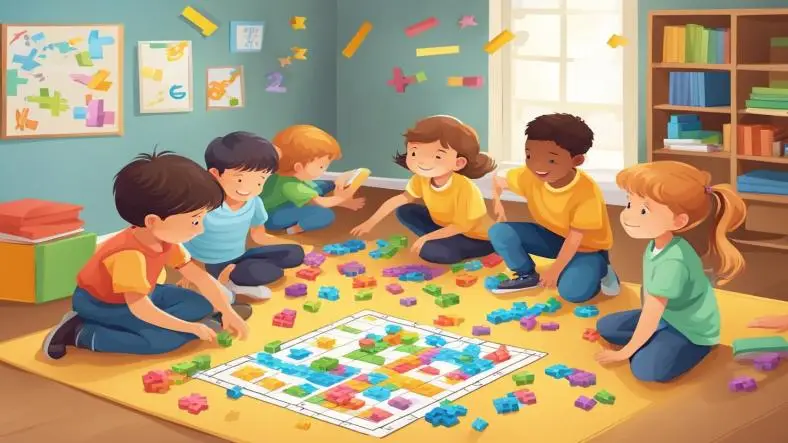Creating and playing math-based board games is a fantastic way for children to learn math concepts while having fun. These DIY games can be tailored to various age groups and skill levels, making math practice engaging and interactive.
Here’s a step-by-step guide to designing and playing your own math board games.
Materials Needed:
- Cardboard or Poster Board: For the game board.
- Markers or Crayons: For drawing and decorating the board.
- Dice: For rolling and determining movement (standard or custom dice with math problems).
- Game Pieces: Small tokens, coins, or any small objects to represent players.
- Index Cards or Paper: For creating question cards or game prompts.
- Glue or Tape: For assembling parts of the game.
- Scissors: For cutting materials.
- Ruler: For drawing straight lines and measuring.
Step-by-Step Guide to Creating Math Board Games:
1. Design the Game Board:
- Choose a Theme: Decide on a theme for your game (e.g., treasure hunt, adventure, space exploration) to make it more engaging.
- Draw the Board:
- On the cardboard or poster board, draw a path with spaces for players to move along.
- You can create a simple linear path, a circular track, or a more complex maze.
- Add Special Spaces:
- Include special spaces where players must solve math problems, lose a turn, or gain extra points.
- Decorate these spaces to match your theme.
- Create Game Elements:
- Start and Finish: Clearly mark the starting point and the finish line on the board.
- Math Challenges: Space out areas on the board where players will encounter math challenges or questions.
2. Create Math Challenge Cards:
- Prepare Index Cards or Paper:
- Write math problems or questions on the index cards or pieces of paper.
- Include various levels of difficulty depending on the players' ages.
- Types of Questions:
- Addition and Subtraction: Basic arithmetic problems.
- Multiplication and Division: More advanced problems.
- Word Problems: To encourage critical thinking.
- Geometry: Questions about shapes and angles.
- Create Question Cards:
- For each challenge space on the board, create a matching card with a math problem.
- Players draw a card when they land on a challenge space.
3. Assemble the Game Pieces:
- Create Game Pieces:
- Use small tokens, coins, or other objects as player pieces.
- You can also create custom game pieces by decorating small objects.
- Prepare Dice: Standard dice can be used, or create custom dice with math problems or instructions on each face.
4. Define the Rules:
- Game Objective: Define the goal of the game (e.g., reach the finish line first, collect the most points).
- Movement:
- Players roll dice to move their pieces along the path.
- The number rolled determines how many spaces to move.
- Math Challenges:
- When landing on a challenge space, players draw a card and solve the math problem.
- Correct answers allow them to continue, while incorrect answers may result in losing a turn or moving back.
- Winning: Decide how players win the game (e.g., reaching the finish line first, answering the most questions correctly).
Sample Game Ideas:
- Math Adventure Game: Create a game where players navigate through different "zones" (e.g., jungle, desert) by solving math problems to advance.
- Treasure Hunt Game:
- Players follow a path to find hidden treasures.
- Each treasure spot has a math challenge they must solve to claim the prize.
- Space Quest: Players move through a space-themed board, solving math problems to complete missions and reach the final planet.
Tips for Success:
- Keep It Fun: Use colors, drawings and themes to make the game visually appealing and enjoyable.
- Adapt Difficulty: Adjust the complexity of the math problems based on the age and skill level of the players.
- Encourage Team Play: For younger children, consider playing in teams to foster collaboration and learning.
Safety Considerations:
- Safe Materials: Ensure all materials used are safe and non-toxic.
- Supervision: Supervise younger children to ensure they use scissors and other tools safely.
Conclusion:
DIY math board games offer a creative and interactive way to reinforce math skills while engaging children in fun activities. By designing their own games, children not only practice math but also develop problem-solving and critical-thinking skills. This hands-on approach makes learning math more enjoyable and memorable, turning educational content into an entertaining experience.
Thanks for reading the article, for more Science and Technology related articles read and subscribe to peoples blog articles.















